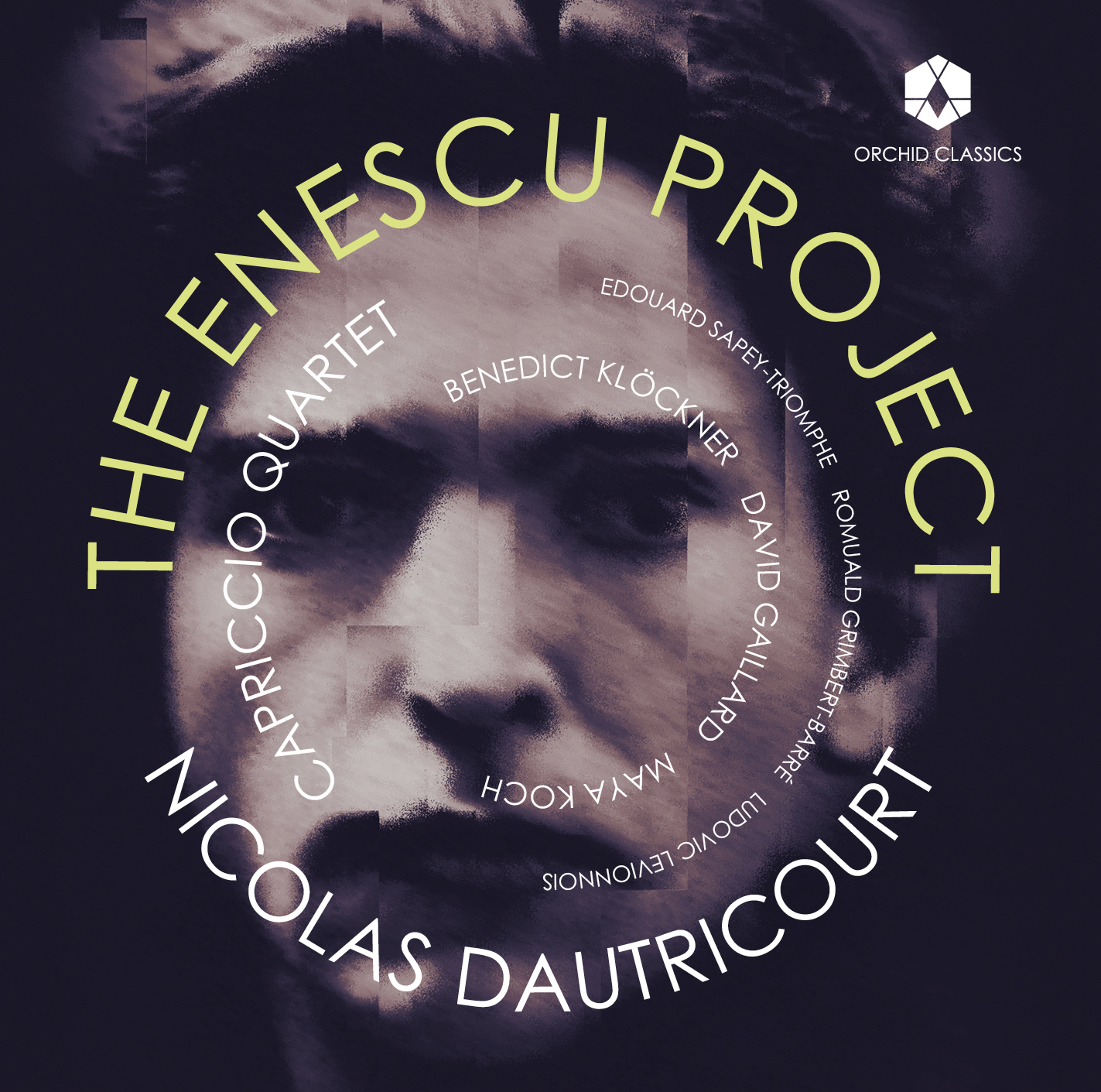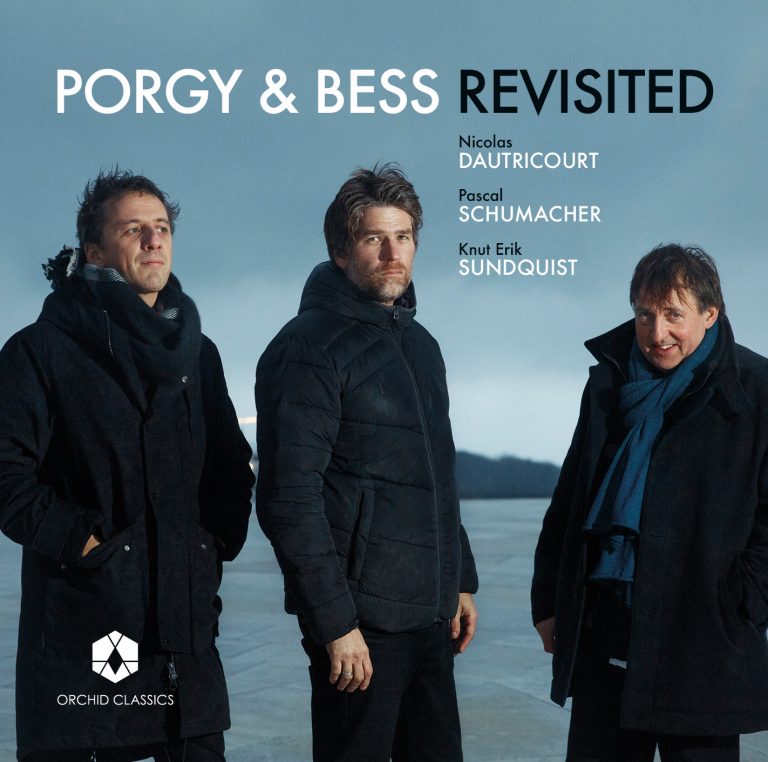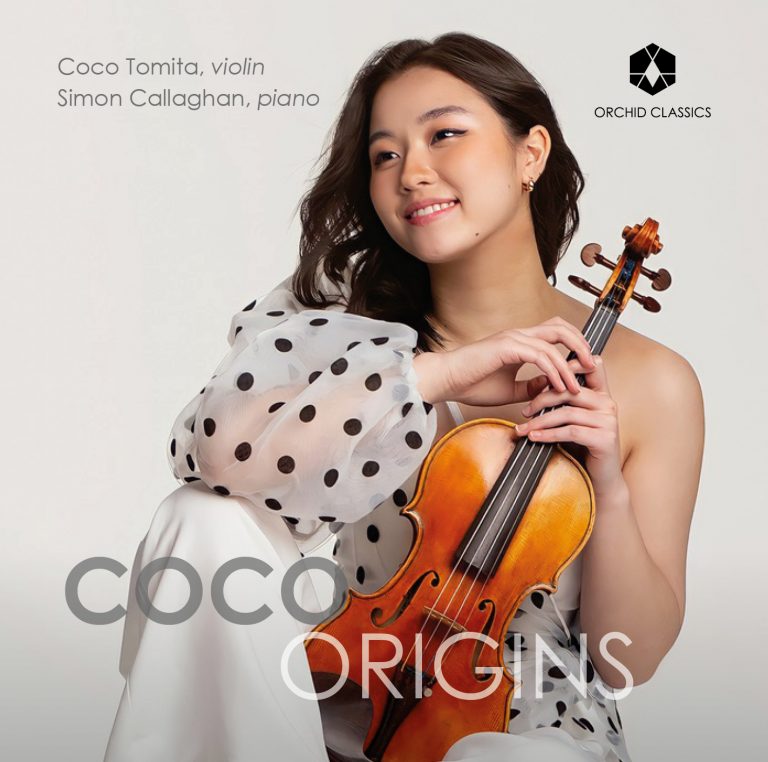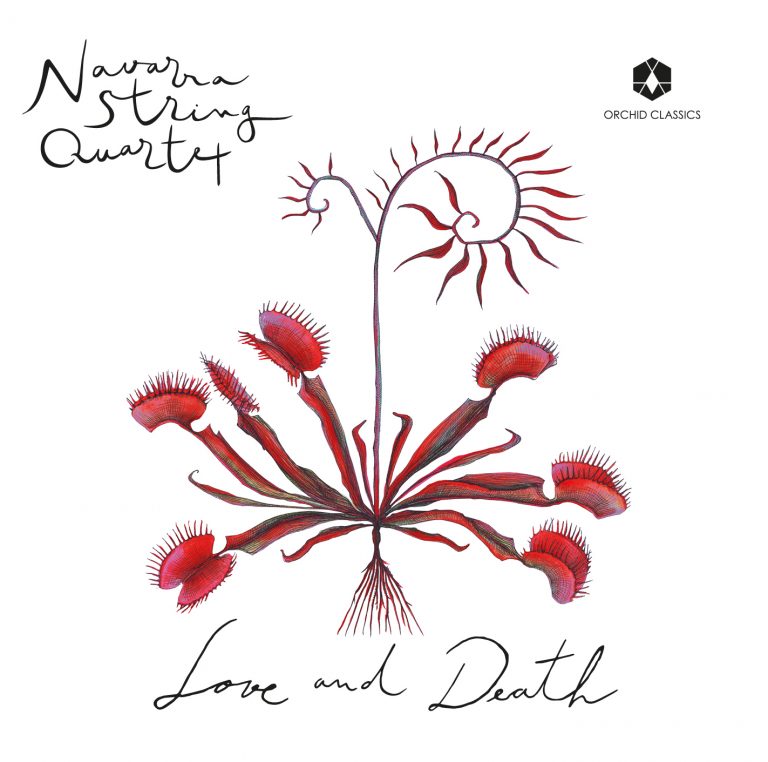Artist Led, Creatively Driven

The Enescu Project
Nicolas Dautricourt
Release Date: September 16th
ORC100202
THE ENESCU PROJECT
George Enescu (1881-1955)
1 Aubade in C major for string trio
Cécile Agator, violin
Flore-Anne Brosseau, viola
Samuel Etienne, cello
Jules Massenet (1842-1912)
2 Méditation de Thaïs
(Arranged for strings by N. Dautricourt)
Cécile Agator, solo violin
Béla Bartók (1881-1945)
3 Three Duets for two violins, Sz.98
Nicolas Dautricourt, violin
Cécile Agator, violin
Eugène Ysaÿe (1858-1831)
4 Sonata No.3 in D minor “Ballade”, Op.27
Dedicated to George Enescu
Nicolas Dautricourt, solo violin
George-Ioan Păiş (b.1994)
5 Mémoire Déformée — hommage à George Enescu for string octet
Nicolas Dautricourt, violin
Capriccio Quartet
Romuald Grimbert-Barré, violin
Ludovic Levionnois, viola
Edouard Sapey-Triomphe, cello
Gabriel Fauré (1845-1924)
6 Élégie in C minor, Op.24
(Arranged for violoncello and strings by A. Lamarre)
Benedict Klöckner, solo cello
Maurice Ravel (1875-1937)
7 Pavane pour une infante défunte
(Arranged for strings by N. Dautricourt)
Nicolas Dautricourt, violin
Capriccio Quartet
George Enescu
Octet for strings in C major, Op.7
8 Très modéré
9 Très fougueux
10 Lentement
11 Mouvement de valse bien rythmée
Nicolas Dautricourt, violin
Capriccio Quartet
Maya Koch, violin
David Gaillard, viola
Benedict Klöckner, cello
THE ENESCU PROJECT, IN CONCERT…
Launched in the summer of 2016, the Enescu Project sprang from a fascination with a piece of music: the Octet for strings in C major Op.7 composed by the 19-year-old George Enescu in Paris in 1900. In my humble opinion this work is one of the greatest masterpieces of the chamber music repertoire, or perhaps of music altogether.
I discovered this piece by accident at the Turina Festival in Seville in 2015. I was in total awe of this music from its first bars, thunderstruck by its beauty, its sweetness, the indescribable charm of its melodies, the incredible force of its character, its audacious and grandiose proportions, the richness of its harmony underpinned by such inventive counterpoint, full of voluptuousness and steeped in intelligence. It was very much like falling in love, when its thunderbolt has blinded us and we tend to feel that the beloved possesses only good qualities: if I had to try to put into words what I felt that summer of 2015 when I first came across the Octet for strings in C major Op.7, it was not a simple crush but indeed love at first sight.
As with many a love story, months passed; the butterflies and wonderment of the beginning of our story gave way to a more rational, deeper love and approach to the music as I began to study the work in depth. Nevertheless, my passion for this magical 32-string quartet remained undeniable and the initial intense thrill that had passed through me when I’d discovered it didn’t disappear. It was then that I promised myself that someday I would write the story of my own connection with this work: a simple and straightforward tale that would clearly highlight my personal and professional investment in it and in George Enescu, its creator.
This programme is presented in two parts, separated by a short intermission. The first part sets out the contours of Enescu’s personality by describing not only his musical career — he had been called the Mozart of the 20th century when he first arrived in Vienna at the age of 10 — but also the musicians with whom he rubbed shoulders or even shared a stage (Béla Bartók, Maurice Ravel) and two of his many teachers: Gabriel Fauré and Jules Massenet. The great Belgian violinist Eugène Ysaÿe even dedicated one of his six sonatas for violin to him; this Ballade Op.27 therefore appears in our programme as well. The pieces are short and for different combinations of instruments: a duo for violin and cello is followed by a string quartet which gives way to a solo instrumental piece before concluding with a string sextet: these changes bring variety and delight to this first part of the programme.
The Enescu Project was performed in concert as part of the George Enescu 2021 International Festival; as a part of this prestigious event and in partnership with the French Institute of Bucharest and the Château Pape-Clément, we had also launched a competition for young Romanian composers. The aim of this competition was twofold: to award a prize to a young composer for the composition of a work in homage to Enescu’s Octet, and to confirm the close cultural and fraternal ties between France and Romania. The competition was won by George-Ioan Păiş from Cluj-Napoca with his magnificent string octet Mémoire déformée; we are particularly proud and happy to have had the opportunity to record it even before its official public première.
Another crucial element of this first part is the manner in which each piece is presented by the musicians themselves. Each musician takes turns to speak, either to share an anecdote or read a letter concerning Enescu or to quote what people of renown had said about him. We believe that this diversity, with its changes of décor, instrumental timbres and voices will break the sometimes-monolithic aspect of a concert; we also trust that this same variety will provide the perfect conditions for our audiences to discover a work or composer unfamiliar to them.
We have now reached the end of the first part of our programme. After a short break, and with an audience now entirely enthralled by Enescu and his music, we conclude the evening with his Octet Op.7.
…ON RECORD
When asked whether we would reproduce the Enescu Project as we had performed it in concert for this recording, we replied that we would; we have taken the gamble of presenting it completely unchanged, in its original concert format.
We wish you the finest of adventures as you discover the world of George Enescu!
Nicolas Dautricourt
The central focus of this recording is George Enescu (1881-1955), not only a great Romanian violinist (teacher of Yehudi Menuhin) and conductor, but also an immense composer and a leading figure of 20th century music. Here we underline Enescu’s French connections, as he had studied at the Paris Conservatoire with Jules Massenet and Gabriel Fauré; he had also befriended his fellow student Maurice Ravel, even though Enescu had already composed a number of works: Claude Debussy, no less, would soon attend the premiere of his first symphony. It is to this spirit that this disc and its unusual programme bear witness, combining well-known works with others that are much less familiar, notably Enescu’s extraordinary Octet, which completes this programme.
Enescu’s output, as varied as it is abundant, is still mostly unfamiliar; it contains works in every genre and is of the same importance as Bartók’s music for Hungary or Janáček’s for Czechoslovakia; Enescu possessed a similar attachment to Romanian traditional music and made this the driving force behind his work. He nonetheless also developed a highly personal and innovative style that was daring both rhythmically and harmonically.
Enescu’s Aubade for violin, viola and cello dates from 1899, when he was barely eighteen years old. It is a fresh and charming work with a fine swaying gait, somewhat in Dvorák’s countrified style, although it is far from the phenomenal Octet Op.7 — to be composed the following year — in size, style and content.
Massenet’s Meditation de Thaïs has been performed in an arrangement for violin and piano throughout the world. In its original form it was a symphonic intermezzo entitled Méditation religieuse from Massenet’s opera Thaïs, first performed in 1894. Almost a nocturne for solo violin, its somewhat sentimental melody expresses the sensual voluptuousness that is supposed to illustrate the heroine’s incorruptible spirituality.
Bartok’s Forty-four Duets for Two Violins, composed in 1831, round off the other masterpieces — the Rhapsody and the two sonatas — that Bartók wrote for the instrument, although they are pedagogical works above all else, like the six Mikrokosmos volumes that he had composed for piano. Bartók himself defined their purpose: “so that students, from their first years of study, can play works in which they can discover the natural simplicity of folk music and its melodic and rhythmic particularities”. These wonderful miniatures were written to introduce children to the magic of folk music, to songs and dances of Hungarian, Romanian and other origins.
Another violin contribution to this recording is Eugène Ysaÿe’s magnificent Sonata No.3 “Ballade” Op.27, dedicated to George Enescu. Somewhat like Enescu although older, Ysaÿe (1858-1931) was a legendary Belgian violinist — a pioneer of the modern school — a conductor, and a composer whose works remain little known. Whilst he composed less than Enescu, he excelled in pieces for violin and orchestra and in chamber music. His six splendid sonatas for solo violin revolutionised the literature for the instrument and reveal a free and whimsical poetic style that at times approaches Enescu’s. The third sonata in D minor is the shortest; it consists of two sections, rhapsodic and virtuosic, of prodigious invention and inspiration.
The Romanian George-Ioan Păiş was born in Cluj-Napoca in 1994; he has always been fascinated by a multitude of subjects and his studies were atypical: he first studied architecture and then graduated from the National University of Music in Bucharest before studying jazz and light music composition under professors Andrei Tudor and George Natsis. He won the Column of Infinity International Composition Competition in 2021 as well as the French Institute of Romania and Château Pape-Clément Prize for his work Mémoire Déformée – hommage à George Enescu for string octet, performed at the Enescu Festival and the Sibiu Opera Festival in 2021. A work of savage beauty in one movement, it is a kind of sublimated traditional dance; as with Enescu, lyricism is always present, despite the inflexible rhythmic determination of the score and its almost Beethovenian theme. This is what remains with us at the end of the piece.
Originally written for cello and piano and later transcribed for cello and orchestra, Fauré’s Élégie (1883) is undoubtedly his most popular work. Originally conceived as the slow movement of a sonata, we hear a long phrase of heart-rending emotion, a sort of funereal lament that is interrupted by a brighter episode before the opening theme returns, now even more poignant in its agitation.
It is well known that Ravel was not very fond of his own Pavane pour une infante défunte. A commission from the Princess de Polignac, originally written for piano in 1899 and then orchestrated in 1910, he said of it: “I see its faults only too well: Chabrier’s influence, which is far too obvious, and its poor formal structure”. It is also reminiscent of the slightly saccharine Russian music of the time that Ravel esteemed, as did Debussy. This Pavane, to which in Ravel’s own words “some little princess might have danced, once upon a time at the Spanish court”, is nonetheless marked by somewhat oversweet melancholy and great elegance; it is touching, if not truly moving, with its long, almost hypnotic ribbon of sound — a process that Ravel was to use in many of his works, right up to his shattering Boléro!
George Enescu’s Octuor à cordes for four violins, two violas and two cellos is one of the summits of the entire chamber music repertoire. Composed in 1900 when Enescu was nineteen, its four movements are integrated into a gigantic sonata form; this vast score achieves an unprecedented synthesis of folk modal writing and the all-embracing chromaticism of the late 19th century. The work exudes an uncommon, almost orgiastic intensity that is matched only by the richness of its structure and its multiple transformations; this is a work of great complexity and dizzying polyphonic density which combines nine adjacent themes, these being transformed continually throughout. At the dawn of the new century and of Enescu’s career, this Octet revealed him as a genius who would leave his mark on the history of music.
© Frédéric Ravel
Nicolas Dautricourt
Violin
Voted ADAMI Classical Discovery of the Year at Midem in Cannes, awarded the Sacem George Enescu Prize, guest artist at the 23rd Victoires de la Musique in Toulouse and a member of the Chamber Music Society of Lincoln Center in New York, Nicolas Dautricourt is one of the most brilliant and engaging French violinists of his generation.
In January 2019 he made his debuts at the Paris Philharmonie with Orchestre National d’Ile de France, performing Prokofiev’s second violin concerto under British conductor Jamie Philipps, and appears regularly at major international venues, including the Kennedy Center, Alice Tully Hall, Wigmore Hall, Moscow Tchaikovsky Hall, Tokyo Bunka Kaikan, Salle Pleyel, Cité de la Musique and Théâtre des Champs-Élysées, among others. He also appears at many classical and jazz festivals such as Lockenhaus Kammermusikfest, Festival Enescu in Bucharest, Music@Menlo, Pärnu, Ravinia, Sintra, Davos, Tokyo and Nantes Folles Journées, Jazz à Vienne, Marciac Jazz Festival, Jazz à la Grange, and has performed with the Detroit Symphony, Royal Philharmonic Orchestra, Orchestre National de France, SWR Saarbrücken, BBC National Orchestra of Wales, Aachen Symphony, Orchestre du Capitole de Toulouse, Quebec Symphony, Oulu Sinfonia, Liège Philharmonic, Sinfonia Varsovia, Novosibirsk Philharmonie, International Players Busan, Mexico Philharmonic, NHK Tokyo Chamber Orchestra and the Kanazawa Orchestral Ensemble, under conductors Leonard Slatkin, Paavo Järvi, Fabien Gabel, Yan Pascal Tortelier, Tugan Sokhiev, Frédéric Chaslin, Stanislas Lefort, Philippe Auguin, David Niemann, Dennis Russell Davies, Wolfgang Doerner, Carlos-Miguel Prieto, Eivind Gullberg Jensen, Gabor Takacs-Nagy, Yuri Bashmet, Michaël Francis, François-Xavier Roth, and Kazuki Yamada.
Awarded in numerous international violin contests, such as Wieniawski, Lipizer, and Belgrade, he has studied with Philip Hirschhorn, Miriam Fried, and Jean-Jacques Kantorow, and since 2021 has been teaching at the Conservatoire à Rayonnement Régional de Versailles.
Artistic director of the “Fêtes Musicales de Corbigny”, Nicolas Dautricourt plays a magnificent instrument by Antonio Stradivari, the “Château Pape-Clément” (Cremona 1713), on loan from Bernard Magrez, and in January 2021, has received from the French Ministry of Culture, the title of Chevalier des Arts et des Lettres.
Capriccio Quartet
The Capriccio Quartet was founded in 2012 and the following year they were awarded at the prestigious Bordeaux International Quartet Competition and won 1st prize at the Illzach International Chamber Music Competition.
Composed of Cécile Agator and Fermin Ciriaco, violins, both Soloists at the Orchestre Philharmonique de Radio-France, Flore-Anne Brosseau, viola, and Samuel Etienne, cello, members of Orchestre de Paris and Ensemble Les Dissonances, they have been invited to perform at the Philharmonie de Paris, Radio France and Cité de la Musique in Paris, and have appeared at numerous festivals including the Quatuor à cordes du Luberon, Flaneries de Reims, Heures musicales du Haut-Anjou, Festival BWD12, Fêtes Musicales de Corbigny and Concerts de midi à Rennes. They have performed with Nicolas Dautricourt, Gérard Caussé, Karine Deshayes, Miguel Da Silva and Yan Levionnois to name a few.
In 2015 the Capriccio Quartet founded the festival “Capriccio en Maine” where they aim to develop bridges between many art forms by mixing them around a common theme and thus share their artistic enthusiasm with a broad audience.
In 2019 they recorded their first CD, Capriccio, which received a five star review from BBC Music Magazine.
Maya Koch
Violin
Maya Koch performs as chamber musician and soloist at venues throughout Europe, Japan and China, including Philharmonie Paris, Wigmore Hall London, Concertgebouw Amsterdam, Teatro della Pergola Florence, Tsuda Hall Tokyo, Forbidden City Hall Beijing, Cheltenham Festival, Festival Angoulem and Prussia Cove. As a chamber musician she has appeared with such artists as Martha Argerich, Bertrand Chamayou, Ivry Gitlis, drawing artists Kim Jung Gi and Camille Jourdy, and as member of the London Conchord Ensemble and Le OFF.
Maya’s recital disc “Paris” for Orchid Classics has received “Selection of the Month” in The Strad magazine. Furthermore, she has released numerous critically acclaimed CDs for Orchid Classics, NoMadMusic, Chandos etc.
Maya studied with Josef Rissin in Karlsruhe, Jean-Jacques Kantorow at the CNSM in Paris and with David Takeno at the Guildhall School of Music in London. Her numerous prizes and awards include the Bach Prize in Baden-Baden and first prize at the International Lions Competition for Violinists in Porto, Portugal.
She has been a member of the Orchestre de Paris since 2010.
David Gaillard
Viola
David Gaillard studied at the CNSM Paris with Jean Sulem, graduating with a first prize “with congratulations of the jury” as well as prizes for harmony and counterpoint.
Following his studies, he became principal viola of the Orchestre de Paris and professor at the CNSM Paris.
As member of the string quartet and orchestra “Les Dissonances” and of the Klezmer ensemble “Sirba Octet” he has appeared on the most prestigious stages throughout Europe. He has recorded, amongst others, two albums with the quartet “Les Dissonances” with works by Franz Schubert and Éric Montalbetti, and a CD with chamber music by Schumann for Indesens.
At the same time, he improvises with the quartet “Supplément d’Ame” of Jean-Philippe Viret that has performed at the jazz festival in Marciac, and has written numerous acclaimed arrangements for Le OFF, a musical collective from the Orchestre de Paris with eclectic projects.
David Gaillard is member of the Quatuor Dutilleux.
Benedict Klöckner
Cello
Benedict Klöckner, born in 1989, is one of the outstanding artists of his generation. He performs worldwide as a soloist with renowned orchestras such as the Royal Philharmonic Orchestra London, Deutsche Radiophilharmonie, NDR Radiophilharmonie, MDR Symphony Orchestra, Deutsche Staatsphilharmonie, Kremerata Baltica, Camerata Oslo and Munich Chamber Orchestra and works with renowned conductors such as Daniel Barenboim, Christoph Eschenbach, Ingo Metzmacher, Michael Sanderling, Clemens Schuldt, Heinrich Schiff and Sir Simon Rattle.
He appears in concert halls such as the Berlin Philharmonie, Carnegie Hall New York, Kennedy Center Washington, Symphony Hall Chicago, Arts Center Seoul, Musikverein Vienna, Gewandhaus Leipzig, Tonhalle Zurich, Gasteig in Munich, Concertgebouw Amsterdam, Rudolfinum Prague, Athenaeum Bucharest and Barbican, Cadogan and Wigmore Hall London.
In the 2022/ 2023 season he performs the 6 Bach Suites at the Berlin Philharmonie, the Alte Oper Frankfurt and releases a CD recording of the Bach Suites.
Benedict Klöckner is a welcome guest at festivals around the world. His chamber music partners include Emanuel Ax, Lisa Batiashvili, Yuri Bashmet, Christoph Eschenbach, Vilde Frang, Anna Fedorova, Gidon Kremer, Anne Sophie Mutter and Sir András Schiff.
Benedict Klöckner plays the “Ex Maurice Gendron” cello by Francesco Rugeri (1680), on generous loan.
Romuald Grimbert-Barré
Violin
A young French violinist, Romuald Grimbert-Barré is the fifth child of a musical family who he has regularly performed concerts with since his childhood.
Romuald has been a prize winner of several international competitions including the China International Violin Competition in Qingdao (2014) and the Oistrakh International Violin Competition in Moscow (2013), and in addition was awarded the prestigious sponsorship from “Fondation Banque Populaire” as a 2012 recipient. He has also been one of the four young musicians titled “Révélation classique 2011” from the French national ADAMI society, which has allowed him to perform in some of the most prestigious venues in France and abroad: Festival Pablo-Casals, Great Tchaikovsky Hall in Moscow, Yamaha Hall in Tokyo, Roque d’Anthéron, Radio-France and Chaise-Dieu.
Romuald regularly performs as a soloist across Europe, Asia and America. Appearances include performances with Orchestre de Chambre Nouvelle Europe (Shanghaï Symphony Hall, Beijing Concerto Hall, Seoul Lotte Hall), Orchestre National de France (Auditorium de Radio France, broadcast live on French National Radio), Moscow State Conservatory Orchestra (Great Tchaikovsky Hall), Orchestre de la Garde Republicaine, Orchestre de la HEM (Switzerland), Qingdao Symphony Orchestra and l’Ensemble Parisien.
Romuald recorded 2 CDs as solo violinist of the Ensemble Grimbert-Barré. He currently lives in Paris.
Ludovic Levionnois
Viola
Ludovic started to study the viola in Angers in the class of François Hetsch before completing his studies at the CNSMD of Paris with Jean Sulem.
Passionate about both chamber and orchestral music, he took part early in his studies in the Academy of the Orchestre Philharmonique de Radio France. He is regularly invited to festivals such as the Festival des Arcs, Heavenly Vaults, or the Festival of Deauville where he had the opportunity to perform alongside prestigious artists such as the Ébène Quartet, the Modigliani Quartet, Svetlin Roussev, Xavier Gagnepain and Guillaume Chilemme.
A versatile artist, he has also performed numerous times with the jazz accordionist Richard Galliano.
Ludovic plays regularly in prestigious ensembles, such as Les Dissonances, the Orchestre Philharmonique de Radio France, and the Orchestre National des Pays de la Loire.
He plays a viola made by Patrick Robin in 2009 and a bow by Yannick Le Canu, both of which were made for him.
Édouard Sapey-Triomphe
Cello
Édouard Sapey-Triomphe began to play the cello with Jean Brizard and Annie Cochet, where he later entered into Michel Strauss’ class at the Boulogne Billancourt Conservatory. After this he studied with Maurice Gendron and Jean Hubeau at the Conservatoire National Supérieur de Musique et de Danse in Paris where he won the first prize in 1986. He then studied with Jean Mouillère and following this went to the USA for 2 years to study with Janos Starker. Upon his return to France, he worked with the Orchestre Philharmonique de Radio France and the Opéra de Paris. He is currently principal cello of Lyon National Orchestra and has taught at the Lyon Superior Conservatory since 1997.
George-Ioan Păiş
Composer
Born in Cluj-Napoca, George-Ioan had his first contact with music in Constanta as a drummer and writer for a local heavy metal band. He originally started his academic studies in architecture, but in 2016 he decided to pursue an education and career in music. He studied Jazz-Pop Composition at the National University of Music, Bucharest (UNMB) and at BA level with Prof. Andrei Tudor, between 2016-2020, graduating as valedictorian. He is currently studying for his MA Degree in classical composition under Prof. Dan Dediu in Bucharest.
An up-and-coming composer on the local scene, he attends and wins various national and international composition competitions and has worked in the most important festivals of the genre in his home country of Romania. He is the winner of the Prix d’Institut Francais de Roumanie and Château Pape-Clément with the work “Memoire Deformee – hommage a George Enescu” for string octet which was played by Nicolas Dautricourt and his Enescu Project octet at the Romanian Atheneum within the Enescu Festival 2021, and with the Sibiu Philharmonic at the Sibiu Opera Festival 2021. He was the 1st prize recipient for the quintet work “Flight of the Golden Birds” (played at the International Week of New Music Bucharest by the Ensemble PROFIL under the conductor Tiberiu Soare, and at the Days of New Music Festival in Chisinau, Rep. Moldova) and also received 1st prize in the national composition competition Stefan Niculescu with the duo work “Small surreal insectarium” for cello and flute. In addition, he was a winner of the Cuarteto Kuikani (Mexico) Call for Scores with the guitar quartet piece “Invocation of Iron”. Besides his portfolio of contest winning pieces, he is also present with commission works for local musicians and ensembles (trio work for Ars Subtilior Ensemble – various concerts; solo marimba piece for Irina Radulescu – first Romanian solo marimba tour).










